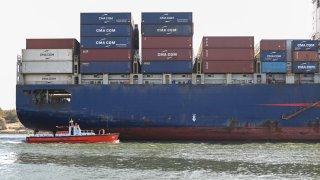
- The Red Sea crisis is having a global ripple effect on freight rates with shipping costs between Asia and the U.S. now spiking as well.
- JPMorgan told clients the fight against inflation could stall in the coming months if shipping costs push the price of goods higher.
- The ultimate economic impact of the Red Sea disruptions remains highly uncertain and will depend on how long the crisis lasts.
U.S. shipping costs are spiking as attacks in the Red Sea disrupt global trade, raising fears that inflation might pick up again if the disruption persists.
The diversion of container ships from the Suez Canal around the Cape of Good Hope in South Africa is having a "global contagion" effect on freight rates, according to a report published by S&P Global Market Intelligence this week.
Trade between Asia and Europe has faced the largest impact with the Suez Canal serving as a crucial gateway between the two regions. The rate for a 40-foot container from North Asia to Europe has surged more than 600% to $6,000 since the outbreak of the Israel-Hamas war in October, according to S&P Global Commodity Insights.
Get top local stories in Connecticut delivered to you every morning. Sign up for NBC Connecticut's News Headlines newsletter.
But the Red Sea crisis is now having a significant impact further afield with shipping costs between Asia and the U.S also spiking. Shipping rates from North Asia to the U.S. East Coast have jumped 137% to $5,100 for a 40-foot container from early October, according to S&P Global. Rates from North Asia to the U.S. West Coast have jumped 131% to $3,700 during the same period.
JPMorgan told clients on Tuesday that the fight against inflation could stall in the coming months if shipping costs push the price of goods higher.
"Renewed increases in global shipping costs may actually add to consumer price inflation over the next several months, should these increases ultimately pass through into higher final goods prices," the investment bank's economic analysts told clients in a research note.
Money Report
"Such an outcome would reinforce our expectation for progress on reducing global core CPI inflation to stall this year," the analysts said.
This could dash market expectations that the Federal Reserve will start slashing interest rates in March. JPMorgan believes the central bank won't start cutting until the middle of the year as core CPI inflation will remain stable in the first half of 2024.
Impact uncertain right now
U.S. National Security Council spokesperson John Kirby told reporters at the White House last week the economic impact of Red Sea disruptions depends on how long the threat goes on.
"But make no mistake, it is a key international waterway, and it can have an effect on the global economy," Kirby said. The Biden administration is concerned, Kirby said, pointing to the multinational maritime force the U.S. is leading to protect vessels.
Consumer prices change slowly and it would take months for them to respond to rising transportation costs if at all, said Chris Rogers, head of supply chain research at S&P Global Market Intelligence. Freight rates remain far below pandemic peak in September 2021 when a 40-foot container cost $18,000.
In most cases, transportation costs represent about 4% to 5% of the price of a good, Mark Hopkins, senior director of economic research for Moody's Analytics, told CNBC.
"Even if you double the transportation costs, we're not talking about something that for some of these goods is going to be really noticeable," Hopkins told CNBC.
"It's not going to measurably alter the outlook that we have for U.S. inflation and therefore not measurably impact what's going to happen with the Fed's decision making," Hopkins said
The first quarter of the year is also not a heavy import period for retailers, said Balika Sonthalia, a senior partner and supply chain expert at the global consultancy Kearney. Most retailers are dealing with inventory that they did not sell during the holidays, Sonthalia said.
The New York Federal Reserve's Global Supply Chain Pressure Index did not show any material increase in December, according to JPMorgan. But the impact of the shipping disruptions could show up with some lag if they remain in place for more than a month, according to the investment bank.
"Increases in shipping costs are likely to pass through into imported goods prices with a lag of some time, and a portion of the pressure is likely to translate into lower profit margins rather than higher prices," JPMorgan's economic analysts told clients in the Tuesday note.
The investment bank estimates shipping disruptions could increase the core goods CPI inflation by 0.5%.
The Red Sea disruptions could have a domino effect on the supply chain if the situation is not resolved by end of the first quarter, HSBC analysts told clients in a note Wednesday. A prolonged blockage could keep freight rates elevated beyond the first half of the year, according to the bank.
Panama Canal crisis
The crisis in the Red Sea compounds disruptions at one of the world's other key trade arteries, the Panama Canal. Drought caused by the El Nino phenomenon has led to reduced water levels, forcing the canal to restrict daily ship transit through the waterway.
The situation is severe enough that Maersk has established a land bridge across Panama for some cargo, avoiding the canal due to low water levels.
Some ocean carriers had originally rerouted trade from Asia to the U.S. East Coast away from the Panama Canal and through the Suez as an alternative. The attacks on vessels in the Red Sea are now forcing shippers such as Hapag-Lloyd to reroute Asia-East Coast trade around the Cape of Good Hope in Africa, according to S&P Global.
Ocean carriers could rely on transpacific routes to the U.S. West Coast as an alternative to the canals, but this raises potential congestion problems at ports.
"We might wind up seeing a significant amount of containers and ships piling up outside of LA Long Beach as we did in previous years," said William George, director of research at ImportGenius.
Some retailers in the U.S. are seeing their supply chains extended by 10 to 14 days as a result of the disruptions, according to Jonathan Gold, vice president of supply chain at the National Retail Federation. Longer trips require more fuel and result in higher costs, he said.
Large retailers are less exposed to the current shipping volatility because they lock in rates through contracts rather than rely on the spot market. The shipping companies can, however, get special permission from the Federal Maritime Commission to implement surcharges for contract customers in emergency situations.
Hapag-Lloyd, Maersk, Mediterranean Shipping Company and CMA-CGM have all received permission to impose hefty surcharges. Hapag-Lloyd, for example, is charging an extra $800 for 20-foot containers and $1,000 for 40-foot containers bound for the U.S. Atlantic and Gulf Coasts from the Middle East and India.
Retailers are able to mitigate the impact on consumers as long as they have clarity about reroutings and delays for contingency planning, according to Jess Dankert, vice president of supply chain at the Retail Industry Leaders Association.
"Uncertainty is really a poison for supply chains," Dankert said. "The longer this stretches out and we have that uncertainty, it becomes more of a challenge."
Don't miss these stories from CNBC PRO:
- There's one stock Wall Street loves so much for 2024 that five analysts in one day picked it as their favorite
- Morgan Stanley names its top stocks for 2024, including this streaming giant
- Investing tips from Warren Buffett to start the new year on the right foot
- Goldman sees a 50% gain ahead for this Chinese electric vehicle stock, initiates with buy rating
- 'Twice as cheap': These stocks' discount to the S&P 500 is double its average, Ritholtz's Brown says






